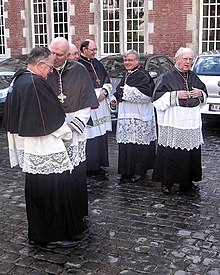
Back Chórový oděv Czech Chorkleidung German Ĥora vesto Esperanto Hábito coral Spanish Korsko odijelo Croatian Pakaian paduan suara ID Abito corale Italian 가대복 Korean Strój chórowy Polish Veste coral Portuguese
This article needs additional citations for verification. (March 2013) |







Choir dress is the traditional vesture of the clerics, seminarians and religious of Christian churches worn for public prayer and the administration of the sacraments except when celebrating or concelebrating the Eucharist. It differs from the vestments worn by the celebrants of the Eucharist, being normally made of fabrics such as wool, cotton or silk, as opposed to the fine brocades used in vestments. It may also be worn by lay assistants such as acolytes and choirs. It was abandoned by most of the Protestant churches that developed from the sixteenth-century Reformation.[1]
Like Eucharistic vestments, choir dress derived originally from the formal secular dress of the Roman Empire in the first centuries of the Christian era. This survived in church usage after fashion had changed.[1] Choir dress differs from "house dress," which is worn outside of a liturgical context (whether in the house or on the street). House dress may be either formal or informal.
- ^ a b Grisebrooke 1978, p. 489, Vestments.
© MMXXIII Rich X Search. We shall prevail. All rights reserved. Rich X Search